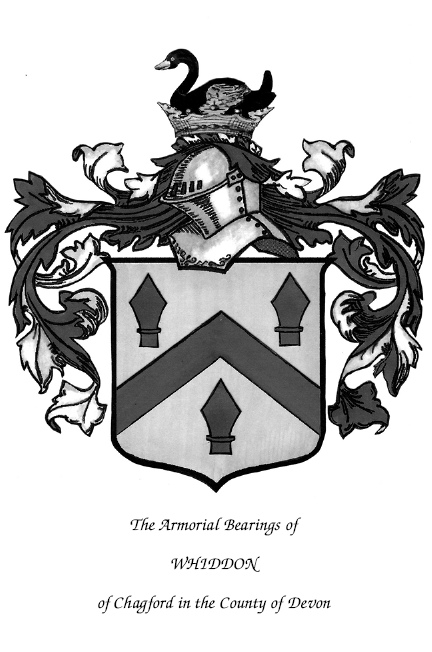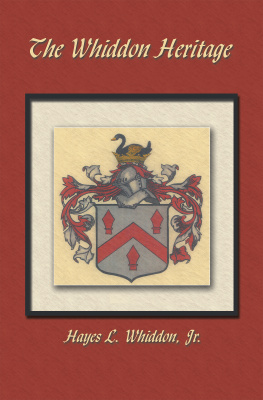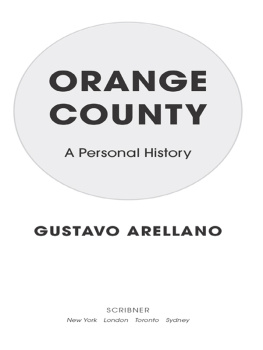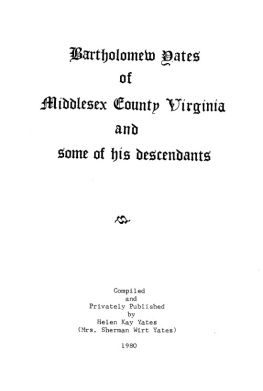The Whiddon Heritage
Hayes L. Whiddon, Jr.

AuthorHouse
1663 Liberty Drive
Bloomington, IN 47403
www.authorhouse.com
Phone: 833-262-8899
2009 Hayes L. Whiddon, Jr. All rights reserved.
No part of this book may be reproduced, stored in a retrieval system, or transmitted by any means without the written permission of the author.
Published by AuthorHouse 10/19/2020
ISBN: 978-1-4389-2984-2 (sc)
ISBN: 978-1-4389-2985-9 (hc)
ISBN: 978-1-6655-0519-2 (e)
Library of Congress Control Number: 2008911610
Any people depicted in stock imagery provided by Getty Images are models,
and such images are being used for illustrative purposes only.
Certain stock imagery Getty Images.
Because of the dynamic nature of the Internet, any web addresses or links contained in this book may have changed since publication and may no longer be valid. The views expressed in this work are solely those of the author and do not necessarily reflect the views of the publisher, and the publisher hereby disclaims any responsibility for them.
Contents
Part I
The Whiddons Of Tudor England
Part II
My Line Of Descent
Part III
The Other Whiddon Lines of Descent
To my beloved grandchildren,
Beau, Lacey, Jesse and Lilly.
One generation passeth away, and another generation
cometh: but the earth abideth for ever.
ECCLESIASTES 1:4
Whiddon Coat of Arms
Whiddons of Chagford, 1300 - 1650
Whiddon Memorial in St. Andrews Church, Moretonhampstead
St. Michaels Church and Three Crowns Hotel, Chagford
St. Michaels Church, Interior View
Tomb of Sir John Whiddon in St. Michaels Church
The Whiddons Southward Journey
Tombstone of William and Mary Whiddon, Emanuel County, GA
Jesse and Amanda, Norfolk County, VA, 1942
Louis, Wyolene and Junior, Norfolk County, VA, 1942
After retirement in 1999, quite by accident, I became interested in the history of my family. As a frequent user of the internet I came across Edward Whiddons web site, which provides the genealogy of the Whiddon family in great detail. His information dovetailed perfectly with research done by my daughter, Catharine, for a Girl Scout project. She put together data on our family going backward that met Edward Whiddons information coming forward. This provided my family line back to its beginning in America. Almost at once this information fell into my hands and provided the spark that piqued my interest in Whiddon genealogy.
I had a coworker in the 1980s who was interested in genealogy and spent a great deal of time doing research on his family in Virginia. He told me that he often came across the Whiddon name in his research and wondered if I would be interested in joining him. At that time I had no interest in genealogy and doubted that this related to my family. I had always assumed that my family immigrated to Georgia from England because my family had lived in Decatur County, Georgia for more than a century before coming to Virginia in 1941.
However, I was to discover the beginning was here, where I live, in Chesapeake, Virginia. Chesapeake was incorporated as a city in 1963 from the area that was formally Norfolk County, where John the Immigrant landed in 1635. Geographic names that were familiar to the first Whiddons are commonplace in my world. I have children who attended both Western Branch High School and Deep Creek High School. At one time I owned a house on Paradise Creek. Four generations of my family worked at the Norfolk Naval Shipyard, located on the Southern Branch of the Elizabeth River. In fact, employment at the shipyard brought my father, grandfather, three uncles and their families to Norfolk County during the Second World War; they came with thousands of others to support the war effort. After the war my father was the only Whiddon to remain as the others returned to familiar surrounding in Georgia and Florida.
I believe the Whiddon story is interesting enough to warrant a book, one that will serve historical and personal purposes. The method I chose in writing this book was not to include as many historical record entries as possible but to tell about my family in narrative form. I have included records that I believe help tell the story. My goal was to make the story as human and personal as I possibly could. One of the great mysteries of genealogy is the why of a situation. The what, where and when can often be determined from available records but generally the why remains unknown.
Included in this book is a section on the Whiddons of Devon, a county of England. It is primarily concerned with the Whiddon family in the Chagford area of Devon.
I wrote an article on Captain Jacob Whiddon that was published in the journal of the Devon History Society. The article appeared in the fall 2007 issue of the Devon Historian, an expanded version is included in this book. The relationship of Captain Jacob Whiddon to the Whiddon family is undetermined.
I chose to research and write primarily about my direct line of descent; however, references to others that enhance the story are included. I tried to plow a straight, deep furrow instead of a broad, shallow coverage of the family as most have done. Beginning with John Whiddon, the Immigrant, I divide each generation into separate sections. The son who is in my direct line of descent is shown in bold typeface and is the subject of the following section.
Also, included are sections on the other two sons of the Immigrant. They are the interesting line of his oldest son John and the short line of Augustine.
The late Edward Whiddon was one of the Whiddon genealogists whose work and insights were extremely valuable in my research. He was a careful researcher whose work, as well as that of several others, was very helpful.
It has often been said by authors acknowledging someone who has benefited their work that it would not have been possible without that person; this has never been truer than in my case. My wife, Elaine, has been a constant encourager of my work and has been invaluable as my editor. She has kept me focused as a writer and ensured that the language in the book was uniform, clear and concise. She is also responsible for the artwork, including painting the Whiddon coat of arms. Most of the credit is hers.
My grandchildren provided the inspiration for me to research and write this book. They are my Whiddon legacy.
Part I
The Whiddons Of Tudor England

The Whiddons of Chagford
in the County of Devon
Devon is a county in the southwest of England between the Bristol and English Channels. It is bound on the west by Cornwall and on the east by Somerset and Dorset Counties. The countryside is hilly with a huge granite plateau dominating the county. The highland is covered by broad moors with the largest being Dartmoor, it is considered southern Englands most beautiful and rugged wilderness.
The area has a history of at least 4,000 years. Devon contains remains of Neolithic settlements and standing stones of druidic origin. During the Roman occupation it was dominated by the Celtic tribe of the Dumnonii, the Deep Valley Dwellers. Devon was a remote region with little Roman influence.
The ancient and small town of Chagford, located in Devon, was the home of the Whiddon family for several hundred years. The town was probably a hamlet in Saxon times. Its location was chosen for proximity to the river for water and to the hills for defense. Chagford is northeast of Dartmoor, in the Teign River Valley. The name Chagford is of Saxon origin, originally spelled Kageford and means the gorsey spot where the river is forded. (Gorse is a shrub with fragrant yellow flowers that grows wild in Devon.) It is likely that the Teign Valley was cleared for farming by the Saxons. In 1086 the manor of Chagford was recorded in the Domesday Book as a farming community with sheep as the primary commodity.
Next page










